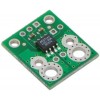



40,41 zł Netto
Pololu 1187 – ACS714 Current Sensor Carrier przeznaczony do bezkontaktowego pomiaru prądu stałego i przemiennego w szerokim zakresie od −30 A do +30 A. Moduł wykorzystuje czujnik Halla ACS714, umożliwiając pomiar prądu bez bezpośredniego włączania rezystora pomiarowego w obwód, co ogranicza straty mocy i nagrzewanie elementów. Rozwiązanie znajduje zastosowanie w systemach zasilania, sterownikach silników, monitorowaniu obciążenia oraz diagnostyce układów mocy.
Czujnik zapewnia galwaniczną izolację pomiędzy mierzonym obwodem prądowym a częścią sygnałową, zwiększając bezpieczeństwo oraz odporność na zakłócenia. Napięcie wyjściowe proporcjonalne do mierzonego prądu wyprowadzone zostało na standardowe piny w rastrze 2,54 mm, co ułatwia integrację z mikrokontrolerami i platformami prototypowymi. Płytka nośna posiada poszerzone pola lutownicze umożliwiające prowadzenie torów prądowych o dużym natężeniu.
Właściwości
W zestawie
Producent BTC Korporacja sp. z o. o. Lwowska 5 05-120 Legionowo Polska sprzedaz@kamami.pl 22 767 36 20
Osoba odpowiedzialna BTC Korporacja sp. z o. o. Lwowska 5 05-120 Legionowo Polska sprzedaz@kamami.pl 22 767 36 20
Moduł z analogowym czujnikiem prądu. Umożliwia pomiar prądu przemiennego i stałego o natężeniu do 50 A. Cytron BB-ACS756
Moduł z czujnikiem prądu ACS724LLCTR-2P5AB o zakresie pomiarowym prądu stałego i przemiennego od -2,5 do +2,5 A. Komunikuje się przez interfejs analogowy. Pololu 4040
Moduł czujnika prądu ACS72981, który wykorzystuje efekt Halla do precyzyjnego i bezpiecznego pomiaru prądu AC oraz DC, zapewniając elektryczną izolację ścieżki prądowej. Dzięki szerokopasmowemu wyjściu analogowemu (do 250 kHz) i niskiej rezystancji przewodzącej (0,2 mΩ) minimalizuje straty energii i oferuje szybki czas reakcji poniżej 2 µs. Pololu 5254
Nowoczesny czujnik prądu o zakresie pomiarowym od -40 A do +40 A, łączący efekt Halla z cewką indukcyjną, co pozwala na precyzyjne pomiary zarówno składowej stałej, jak i zmiennej do 5 MHz. Dzięki błyskawicznemu czasowi reakcji oraz niskiej rezystancji ścieżki doskonale sprawdza się w systemach sterowania silnikami, przetwornicach mocy i układach zabezpieczeń. Pololu 5231
Moduł czujnika prądu ACS72981, który wykorzystuje efekt Halla do precyzyjnego i bezpiecznego pomiaru prądu AC oraz DC, zapewniając elektryczną izolację ścieżki prądowej. Dzięki szerokopasmowemu wyjściu analogowemu (do 250 kHz) i niskiej rezystancji przewodzącej (0,2 mΩ) minimalizuje straty energii i oferuje szybki czas reakcji poniżej 2 µs. Pololu 5251
Kompaktowy czujnik prądu oparty na technologii Halla, umożliwiający dokładny pomiar prądu DC i AC w zakresie ±30 A z galwaniczną izolacją. Ma analogowe wyjście VOUT z dużą czułością i pasmem 150 kHz, co pozwala na szybkie i precyzyjne odczyty w dynamicznych układach. Moduł pracuje w szerokim zakresie temperatur od -40°C do 125°C, a niska rezystancja ścieżki prądowej minimalizuje straty energii. Dzięki niewielkim wymiarom i elastycznym opcjom montażu jest idealny do zastosowań w prototypach, systemach przemysłowych i projektach o ograniczonej przestrzeni. Pololu 5445
Moduł z czujnikiem prądu ACS724LLCTR-10AU o zakresie pomiarowym prądu stałego i przemiennego od 0 do 10 A. Komunikuje się przez interfejs analogowy. Pololu 4042
Moduł z czujnikiem prądu ACS724LLCTR-30AB o zakresie pomiarowym prądu od -30 do +30 A. Komunikuje się przez interfejs analogowy. Pololu 4047
Kompaktowy czujnik prądu oparty na technologii Halla, umożliwiający dokładny pomiar prądu DC i AC w zakresie ±30 A z galwaniczną izolacją. Ma analogowe wyjście VOUT z dużą czułością i pasmem 150 kHz, co pozwala na szybkie i precyzyjne odczyty w dynamicznych układach. Moduł pracuje w szerokim zakresie temperatur od -40°C do 125°C, a niska rezystancja ścieżki prądowej (~1,6 mΩ) minimalizuje straty energii. Dzięki niewielkim wymiarom i elastycznym opcjom montażu jest idealny do zastosowań w prototypach, systemach przemysłowych i projektach o ograniczonej przestrzeni. Pololu 5453
Precyzyjny czujnik prądu oparty na efekcie Halla, oferujący izolację galwaniczną, szerokie pasmo przenoszenia 150 kHz oraz możliwość pomiaru prądu AC i DC z bardzo niskimi stratami mocy. Dzięki różnicowemu pomiarowi i odporności na zakłócenia magnetyczne, doskonale sprawdza się w aplikacjach wymagających dokładnego monitorowania prądu, takich jak zasilacze, przetwornice czy systemy sterowania silnikami. Pololu 5291
Moduł czujnika prądu ACS72981, który wykorzystuje efekt Halla do precyzyjnego i bezpiecznego pomiaru prądu AC oraz DC, zapewniając elektryczną izolację ścieżki prądowej. Dzięki szerokopasmowemu wyjściu analogowemu (do 250 kHz) i niskiej rezystancji przewodzącej (0,2 mΩ) minimalizuje straty energii i oferuje szybki czas reakcji poniżej 2 µs. Pololu 5262
Płytka umożliwia precyzyjny i bezpieczny pomiar prądów do ±15,5 A w systemach wbudowanych. Płytka sprawdza się w projektach sterowania silnikami, monitorowania poboru energii oraz aplikacjach robotycznych, oferując izolację galwaniczną, analogowe wyjście i łatwą integrację z mikrokontrolerami. Pololu 2452
Pomiar prądu o wartości 0 - 5A realizowany jest przez układ ACS712-05 działający w oparciu o efekt Halla. Czułość układu wynosi 185mV / A (sygnał analogowy).
Brak towaru
Nowoczesny czujnik prądu o zakresie pomiarowym od -40 A do +40 A, łączący efekt Halla z cewką indukcyjną, co pozwala na precyzyjne pomiary zarówno składowej stałej, jak i zmiennej do 5 MHz. Dzięki błyskawicznemu czasowi reakcji oraz niskiej rezystancji ścieżki doskonale sprawdza się w systemach sterowania silnikami, przetwornicach mocy i układach zabezpieczeń. Pololu 5234
Moduł czujnika prądu ACS72981, który wykorzystuje efekt Halla do precyzyjnego i bezpiecznego pomiaru prądu AC oraz DC, zapewniając elektryczną izolację ścieżki prądowej. Dzięki szerokopasmowemu wyjściu analogowemu (do 250 kHz) i niskiej rezystancji przewodzącej (0,2 mΩ) minimalizuje straty energii i oferuje szybki czas reakcji poniżej 2 µs. Pololu 5261
Czujnik pozwala mierzyć natężenie prądu płynącego w przewodzie bez jego rozcinania. Pomiar odbywa się w sposób indukcyjny na pojedynczym przewodzie. Wyjściem sensora jest napięcie analogowe w zakresie od 0 do 1 V. SCT-013-015

